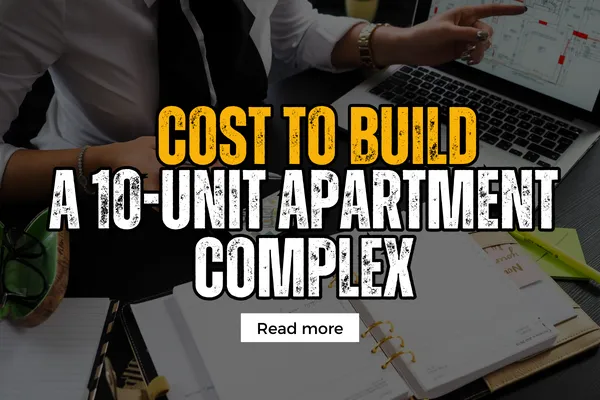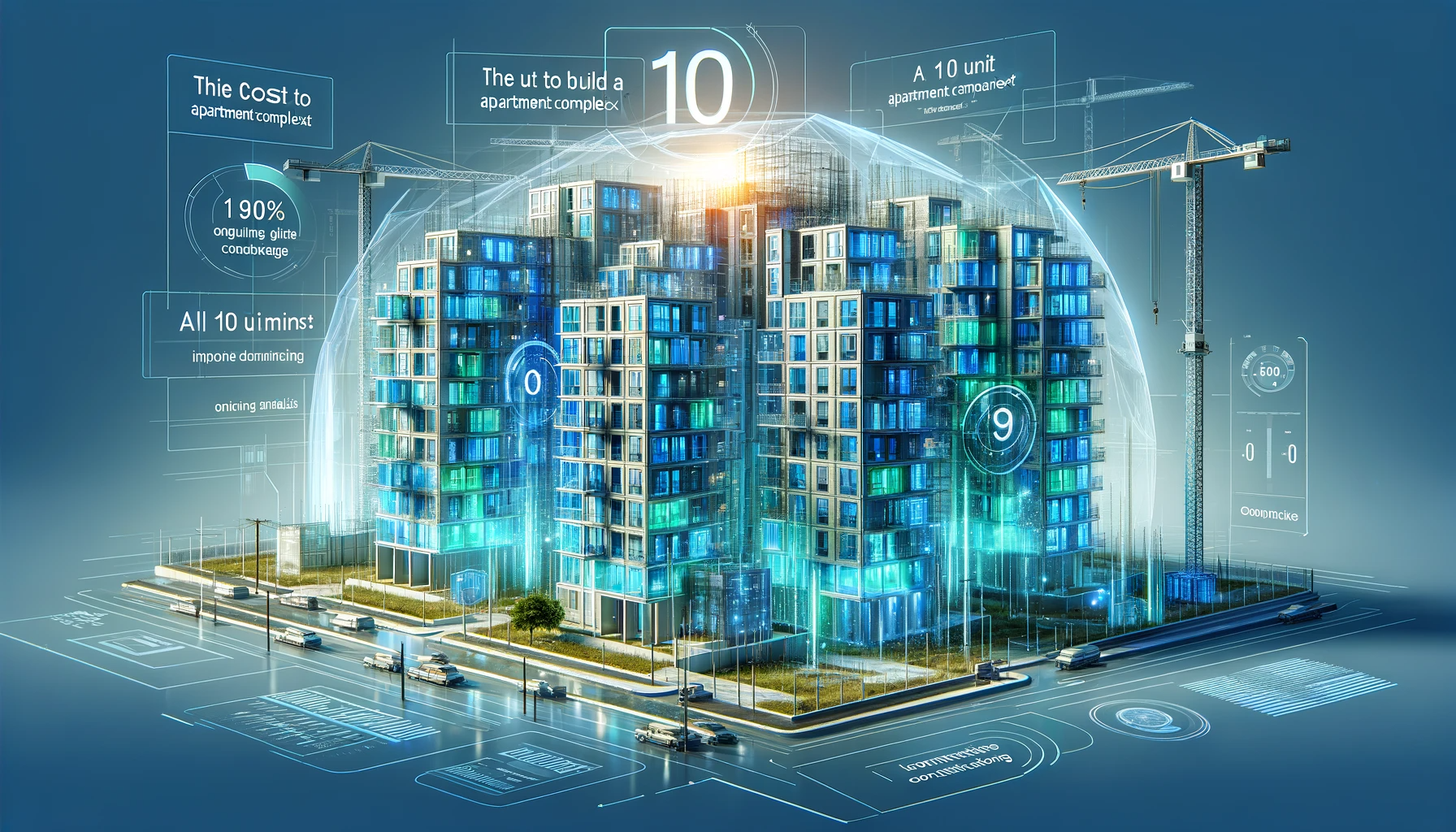Ben Lovro Blogs
AI' Client Conversion Framework

Cost to Build a 10-Unit Apartment Complex
Introduction
Investing in real estate, particularly in the construction of apartment complexes, can be a lucrative venture. One key consideration when embarking on such a project is understanding the cost involved in building a 10-unit apartment complex. The total cost encompasses various factors, from land acquisition and construction expenses to permits and design considerations.

Land Acquisition and Preparation
The first step in building an apartment complex is acquiring the land. The cost of land can vary significantly based on location, size, and zoning regulations. Urban areas tend to have higher land prices, while suburban or rural areas may offer more affordable options. Additionally, the condition of the land, including grading and site preparation, can impact costs. Site preparation may involve clearing vegetation, excavation, and ensuring proper drainage, all of which add to the initial expenses.
Architectural and Design Fees
Designing a functional and attractive apartment complex is crucial for its success. Architectural and design fees cover the services of professionals who create the building's layout, floor plans, and aesthetic elements. These fees can vary based on the complexity of the design and the experience of the design team. Additionally, engaging architects and designers who are familiar with local building codes and regulations is essential to ensure compliance throughout the project.
Construction Costs
Construction costs represent a significant portion of the overall expense. Factors influencing construction costs include:
Materials: The type and quality of construction materials, such as concrete, steel, wood, and insulation, impact the cost. Sustainable or energy-efficient materials may also add to expenses.
Labor: Labor costs encompass hiring skilled workers, including carpenters, plumbers, electricians, and laborers. Labor costs can vary based on local wage rates and the demand for construction workers.
Site Work: Site work includes excavation, foundation construction, utilities installation, and landscaping. The complexity of site work can affect costs.
Permits and Inspection Fees: Building permits and inspections are essential for ensuring compliance with local regulations. Fees for permits and inspections vary by jurisdiction.
Contingency: It's wise to allocate a contingency fund for unforeseen expenses or changes during construction. Contingency funds typically range from 5% to 10% of the total construction budget.
Utilities and Infrastructure
Utilities and infrastructure play a pivotal role in the construction of a 10-unit apartment complex. These essential components ensure that the complex operates smoothly and meets the needs of its tenants. Infrastructure costs encompass the installation of critical systems like water supply, sewage, electrical wiring, gas lines, and internet connectivity.
The complexity of these connections can vary depending on the location of the complex. In some cases, connecting to existing utilities may be straightforward, while in undeveloped areas, extensive work may be required. Utilities and infrastructure expenses are not to be underestimated, as they are fundamental to the functionality of the complex.
Proper planning and allocation of resources in this category are vital to ensure that tenants have access to essential services while maintaining the property's overall value. A well-executed utility and infrastructure plan can enhance the marketability and long-term success of the apartment complex.
Interior Finishes and Amenities
Interior finishes and amenities play a pivotal role in shaping the appeal and functionality of a 10-unit apartment complex. These elements encompass the materials, fixtures, and features that occupants will interact with daily. The choice of interior finishes, such as flooring, cabinetry, and fixtures, can significantly impact construction costs. Opting for high-end finishes may raise expenses but can enhance the overall quality of the units and attract discerning tenants.
Additionally, amenities like fitness centers, community lounges, and outdoor spaces contribute to the complex's marketability and tenant satisfaction. While incorporating these features adds to the upfront investment, they can yield long-term benefits by commanding higher rents and increasing tenant retention. Careful consideration of interior finishes and amenities is crucial, as it strikes a balance between budget constraints and the desire to create an appealing and competitive apartment complex in the rental market.
Landscaping and Exterior Features
Landscaping and exterior features play a crucial role in the overall appeal and value of a 10-unit apartment complex. These aspects encompass the design and installation of outdoor elements such as green spaces, gardens, pathways, lighting, parking facilities, sidewalks, and signage. While they contribute to the property's aesthetics, they also enhance functionality and tenant satisfaction.
Well-maintained landscaping and thoughtfully designed exterior features create an inviting environment for residents and visitors. Additionally, they can improve the property's curb appeal, attracting potential tenants and potentially increasing the complex's overall value in the real estate market.
Legal and Administrative Expenses
Legal and administrative expenses are crucial aspects of any construction project, including building a 10-unit apartment complex. These expenses encompass various costs associated with navigating the legal and administrative requirements. Legal fees come into play for contracts, permits, and ensuring compliance with local regulations.
Insurance premiums and administrative expenses related to project management and compliance need to be factored in. These expenses are essential for ensuring that the project adheres to legal standards and operates smoothly. Proper management of legal and administrative aspects is vital for the success and legality of the construction endeavor.
Financing Costs
Financing costs are a significant consideration when embarking on the construction of a 10-unit apartment complex. These costs encompass the expenses associated with securing the necessary financing for the project. This may include interest on construction loans, loan origination fees, and other financial-related expenses.
The interest rate and terms of the loan can impact the overall cost of borrowing. Proper financial planning and a clear understanding of financing options are crucial to managing these expenses effectively. Investors and developers must evaluate different financing sources and choose the option that aligns with their budget and investment goals, ensuring the project's financial viability.
Marketing and Leasing Expenses
Marketing and leasing expenses play a crucial role in the successful operation of a 10-unit apartment complex. These costs encompass various activities aimed at attracting and retaining tenants. Expenses include advertising efforts to promote the property, leasing agent fees for tenant placement, and expenses related to tenant screening services.
A well-thought-out marketing and leasing strategy are vital for filling vacancies quickly, minimizing revenue losses, and maintaining a steady rental income. Effective marketing not only helps in finding suitable tenants but also contributes to the long-term financial viability of the apartment complex.
Contingency and Miscellaneous Expenses
Contingency and miscellaneous expenses hold a significant role in ensuring the project's success. Contingency funds are essential because they act as a safety net for unforeseen challenges or changes during construction. Typically ranging from 5% to 10% of the total construction budget, these funds provide financial flexibility when unexpected issues arise.
Miscellaneous expenses encompass various costs that may not fit neatly into other categories but are crucial nonetheless. These can include builder's risk insurance, project management software, and other incidentals. Builder's risk insurance, for example, provides coverage in case of damage or loss during construction, offering peace of mind and financial protection.
While often overlooked, these contingency and miscellaneous expenses play a pivotal role in project planning and financial management. They serve as a buffer against the uncertainties of construction, helping projects stay on track and within budget. Properly accounting for these expenses is a prudent and strategic approach that contributes to the overall success of the endeavor.
Local Factors and Regulations
Local factors and regulations play a pivotal role in the cost and feasibility of building a 10-unit apartment complex. These factors can vary significantly from one location to another and have a substantial impact on the overall project. For instance, land prices can differ greatly based on the region, with urban areas typically commanding higher prices than suburban or rural locations. Labor availability and wage rates also vary by locality, influencing construction costs.
Moreover, the permitting process and regulatory requirements may differ, affecting the timeline and administrative expenses of the project. Zoning regulations and land use policies can dictate the type of construction allowed in specific areas, further shaping the project's design and costs. Therefore, it is crucial for investors and developers to conduct thorough research and engage with local authorities to gain a comprehensive understanding of these regional factors and regulations, enabling them to make informed decisions and develop a realistic budget for their apartment complex construction project.
Total Cost Estimation
To estimate the total cost of building a 10-unit apartment complex, a comprehensive approach is necessary. This estimation involves considering every aspect of the project, from land acquisition to marketing expenses. A detailed budget that includes construction costs, architectural and design fees, utility connections, legal and administrative expenses, and contingency funds provides a clear picture of the financial requirements.
Additionally, local factors and regulations play a crucial role in cost estimation, as they can vary widely by region. By meticulously evaluating each cost category and accounting for potential contingencies, investors and developers can ensure that their project remains within budget and aligns with their financial goals.
Conclusion
Building a 10-unit apartment complex is a substantial undertaking that involves various cost considerations. Prospective investors and developers must carefully assess all expenses, including land acquisition, construction, design, utilities, and legal fees, to create a realistic budget. Thorough planning and due diligence are essential for ensuring that the project stays within budget and meets its financial objectives. While the initial costs may seem daunting, a well-executed apartment complex can generate a steady stream of rental income and offer long-term value, making it a potentially rewarding investment.
Contact Us

Bet On Yourself
Empowering entrepreneurs and real estate investors with the tools they need to scale.
ben@clientpro.ai
(803) 921-9915
100 Old Cherokee Road ste f 342





